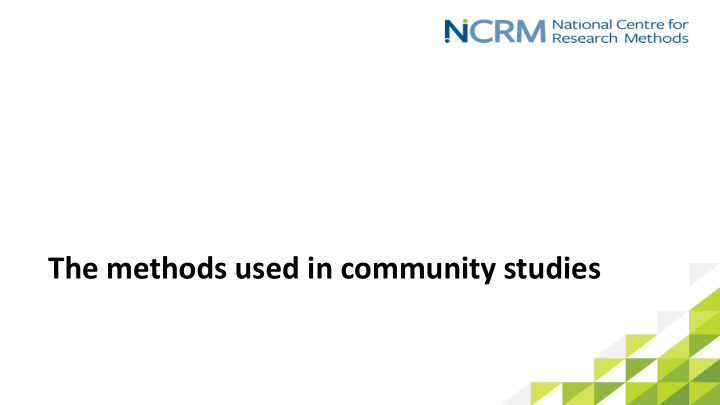



The methods used in community studies
• Community studies are associated with various research methods, often in some combination. • Most commonly, they are associated with ethnographic research methods.
• Community studies appeal because they provide vivid descriptions of community members’ lives. • Fieldwork of a year is often mentioned. Keeping a fieldwork notebook is a key skill.
• Observation is frequently combined with participation (‘participant observation’). • Participation in community activities often leads to deeper understanding.
• Participation also helps to gain access and build trust. • Exit from the field can be difficult; an exit strategy needs to be planned.
• Ethnographic fieldwork frequently involves interviews of various types.
• Walking interviews have grown in popularity.
• Visual methods are employed in their own right as a way of capturing ‘community’.
• Photographs are not the only visual material. Maps are another. • Maps can take several forms, e.g. network maps.
• This social network map shows dense kinship connections between dots (households) in an upland parish in Wales studied by Alwyn Rees (1950).
• The connections shown are only those within the administrative area. • Visual material is selective in the same way that other types of data are.
• Partial coverage can be a serious problem with the use of documentary materials, especially historical documents.
• Nevertheless, documents provide an important safeguard against the problem of past community relationships being romanticised.
• Concern over the unreliability of subjective impressions is one reason why community researchers may use surveys.
• Even so, there are systematic patterns of uneven involvement in survey research in relation to gender, ethnicity, age, and other lines of social division.
• Official statistics are another quantitative method. • Swansea census data showed that patterns of household formation had changed dramatically.
• Recently-married people typically used to live with one or other set of parents, but this has virtually disappeared (Nickie Charles et al. Families in Transition, 2008).
• The comparative method can be useful, studying the same community at two points in times or studying two or more communities.
• This has particular appeal in research designed to address a policy issue. • Sometimes opportunities arise when policy initiatives take the form of natural experiments.
• Many research methods are available, including ethnographic observation, interviews, visual methods, social network analysis, documentary analysis, surveys, official statistics, comparative methods, and several more.
• With so many methods available, community studies typically involve a mixed methods approach (combining quantitative and qualitative elements), or at least a multi-method approach.
• Methodological pluralists argue that no one key opens every lock, and so a flexible combination of methods has advantages.
• But there is no certainty that the results of different methods will combine smoothly. • People’s accounts of community relationships and official statistics may be in tension.
• Not all approaches to research into community relationships sign up to methodological pluralism. • For action researchers, their value stance and commitment to change agendas makes their approach distinct.
• Action researchers use participatory methods which tend to favour a sub-set of the of methods available.
• There will also be personal preferences involved in the choice of methods. • Rarely are individuals skilled practitioners of the full range of methods available.
• Teams reduce this problem, but create others. • And choices will be influenced by what previous researchers did, if links are made to their work in order to build a cumulative body of knowledge.
Recommend
More recommend